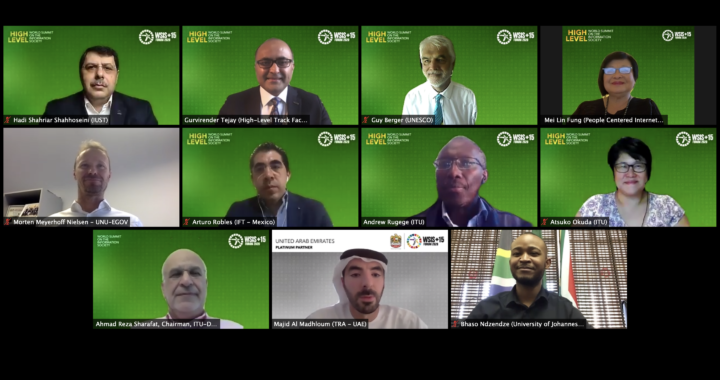
What Can We Learn From The Original Spirit And Spread Of The Internet, For The Building Of Capacity And E-Learning In Knowledge Societies That Can Foster The Achievement Of The UN Sustainable Development Goals By 2030?
The Internet spread, not through the UN or the World Bank, but because individual people cared! In 2014, here in Silicon Valley, with one of the fathers of the Internet, Vint Cerf, I organized the 40th anniversary of the TCP/IP specification which underlies the Internet.
The US National Science Foundation funded the spread of the Internet, so professors could collaborate on research, through the National Research and Education Networks or NRENS’s. “Network Information Centers” allowed faculty and students to connect to global counterparts.
At our open-air celebration of the Internet’s 40th birthday, in a park in Palo Alto, people talked about how the Internet came to their country. Many of them took risks in order to connect their country to the Internet. The widow and daughter of the Moscow State University professor told us that connecting Russia to the Internet was what he was proudest of doing in his life.
The people at the 40th anniversary were thrilled and amazed they changed the world! Now the Internet is the infrastructure that underlies all other infrastructures, transforming Industries music, finance and banking, the global supply chain and now government and politics are in flux. With COVID, the shift to digital – in remote work, e-learning, online-shopping, eating, socializing happened in a few weeks, instead of taking 5-10 years.
Friendship and empathy are what fueled the spread of the Internet. I learned this from Internet pioneers: Vint Cerf, my co-founder of the People Centered Internet and Douglas Engelbart, the inventor of the computer mouse at SRI. UCLA and SRI were the first two nodes of the Internet.
For the first time the UN is headed by an electrical engineer: Antonio Guterres, Secretary General created the UN High Level Panel for Digital Cooperation. I am excited about the Digital Cooperation Roadmap especially the project underway called GIGA. It’s led by the ITU and UNICEF and aims to connect all the schools of the world. Just like the original Internet where universities trained local students to set up and operate the network equipment, GIGA is the next wave of the Internet whereby local people can design and operate school NIC’s.
Ndemo Bitange was at the University of Nairobi in Kenya and helped set up their NIC. This set Ndemo on his future career – he became Permanent Secretary of ICT for Kenya and in that role, opened the door for mobile money and the creation of MPESA.
Today digital technology brings perils as well as promise. Connecting the schools safely means regulators have to assure that technologies Do No Harm. I commend the ITU for #Reg4Covid and in 2019 WSIS, Regulators on the digital frontier spoke about the importance of “share and learn” together in Regional (cross border) networks. National implementations can be improved by sharing breakthroughs and building on lessons learned by neighbors. Regulatory learning networks are needed to keep up with rapid change and the constant cyber attacks. Regional networks are also key to designing regional infrastructure built on common digital building blocks (Appendix 1) This can decrease by ten-fold the cost of health, education, social support systems. I know because I am from Singapore where this strategy has been underway for 2 decades with huge cost savings. Singapore is also the home of the DQ Institute – Digital Quotient – recognized by OECD, IEEE and others for assessing child and adult digital literacy.
Local skill development, community leadership, support for local innovation are critical parts of the next wave of the Internet with GIGA. People have the energy to realize aspirations, build digital capacity and achieve the SDG’s, provided we remove the barriers. This will require[1] regional investment in digital public goods, digital networks (Appendix II) and infrastructure for learning and participating in global trade in goods and services.
As Kenya showed with Ndemo, we MUST seize the opportunity to develop the Ndemo’s of the 21st century in every school in every village in every province and every town. Only then can we achieve the UN SDG’s with everyone working together, digitally cooperating in the age of digital interdependence. This talk is built on the foundation of feedback from members of the NextNow and People Centered Internet communities, I am grateful for their inspirations for this talk.
“When the story of these times gets written, we want it to say that we did all we could, and it was more than anyone could have imagined.” — Bono
What happens in the next few years will change the future, and these changes will last for generations. What we do together now really matters.
Just like at the beginning of the Internet.
Appendix I: Digital Interoperable Building Blocks
Appendix II: Digital Networks for knowledge societies, Building Capacity & e-Learning
Credit – Jeff Saperstein, Hunter Hastings “ Interconnected Individuals: Seizing Opportunity in the Era of AI, Platforms, Apps, and Global Exchanges.” www.interconnectedindividuals.com

1 comment